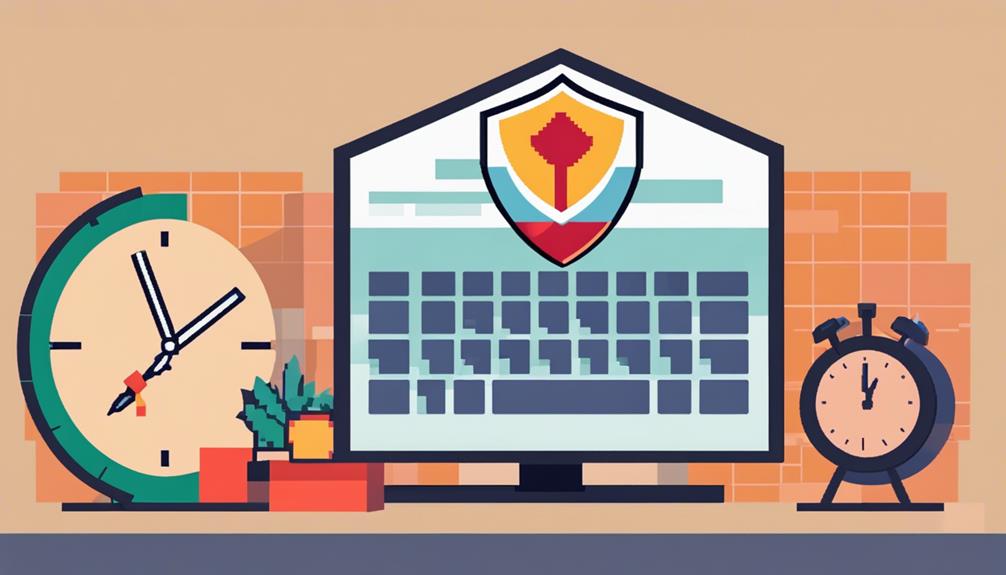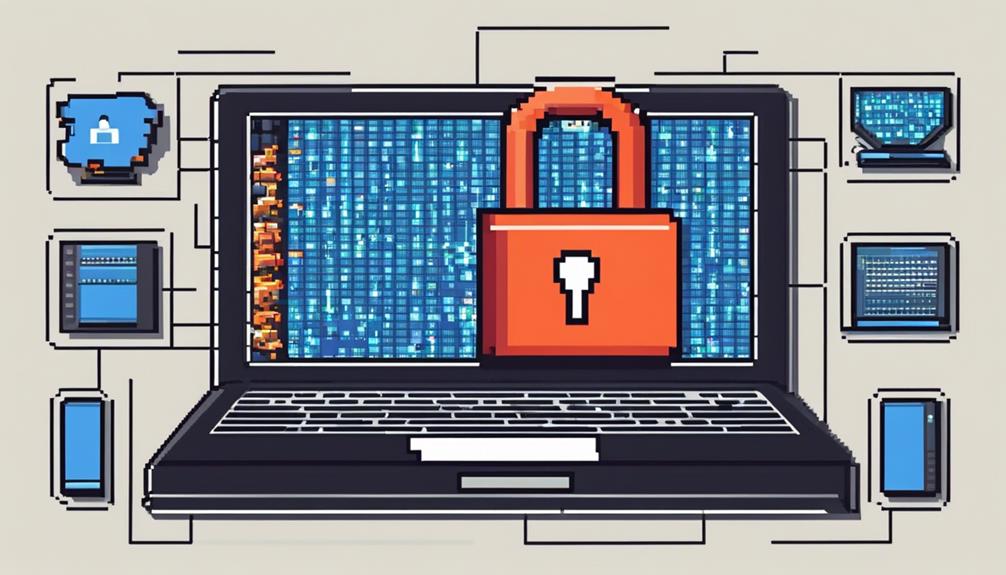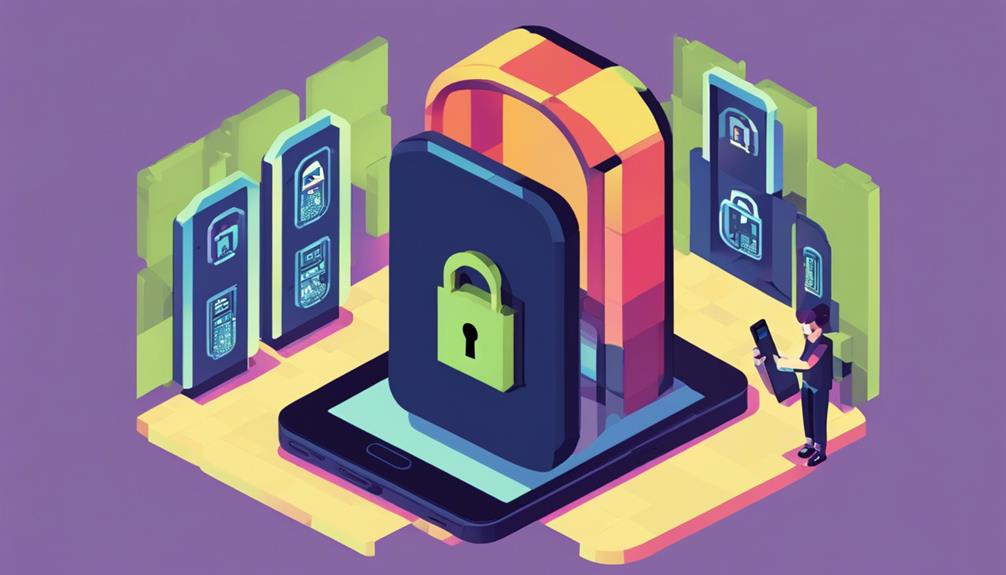To keep your HP15 safe from hackers, prioritize data protection with strong encryption. Secure Wi-Fi by avoiding public networks and using VPN services. Maintain updated antivirus software to defend against cyber threats. Practice safe email habits with strong passwords and avoid phishing scams. Enable multi-factor authentication for added security. Monitor for suspicious activity and educate users on cybersecurity best practices. These essential tips will help safeguard your HP15 and sensitive information effectively.
Key Takeaways
- Implement strong data encryption to protect sensitive information.
- Use secure network connections like encrypted Wi-Fi and VPN services.
- Update antivirus software regularly to shield against cyber threats.
- Avoid public Wi-Fi networks; secure home networks with password protection.
- Educate users on cybersecurity best practices and the importance of awareness.
Implement Strong Data Encryption
One essential step in securing your HP15 from potential cyber threats is to implement robust data encryption protocols. Data encryption is a process that scrambles information on your device, rendering it unreadable without the encryption key. This is vital to protect sensitive information such as passwords, financial data, and personal files from unauthorized access.
By encrypting your data using tools like BitLocker for Windows or FileVault for Mac, you create a secure barrier that guarantees even if your HP15 is stolen or hacked, cybercriminals cannot access the protected information. Strong data encryption acts as a proactive measure against data breaches, safeguarding your HP15 and maintaining the confidentiality of your data.
It is important to prioritize implementing strong data encryption on your HP15 to fortify its security and shield your sensitive information from potential threats.
Avoid Public Wi-Fi Networks

Utilizing public Wi-Fi networks poses a significant security risk due to their susceptibility to hacking and lack of encryption measures. Public Wi-Fi networks, with 70% lacking encryption, are prime targets for hackers seeking to intercept data.
Cybercriminals can easily access sensitive information, such as during online banking, when connected to public Wi-Fi. Without a VPN, personal data is at risk, yet 95% of public Wi-Fi users remain unaware of the lurking security threats.
To exacerbate matters, hackers often create fake Wi-Fi hotspots to lure unsuspecting users and steal their data. Hence, it is important to steer clear of unsecured public Wi-Fi networks.
Safer alternatives like using cellular data or personal hotspots offer more secure options for browsing the internet while on the go. By avoiding public Wi-Fi and utilizing secure network connections, the risk of falling prey to hackers' malicious activities significantly decreases.
Use Secure Network Connections

To guarantee the security of your HP15, it is vital to use encrypted Wi-Fi connections and implement a strong password for your network.
Additionally, consider utilizing a Virtual Private Network (VPN) for an extra layer of protection against potential hackers.
Secure network connections are essential in safeguarding your device and sensitive information from unauthorized access and data breaches.
Secure Wi-Fi Networks
Consider securing your HP15 by connecting to Wi-Fi networks with robust encryption protocols like WPA2 or WPA3. By following these essential tips, you can enhance the security of your device:
- Avoid Public Wi-Fi Networks: Public Wi-Fi networks are often less secure, making it easier for hackers to intercept your data. Opt for secure networks, such as those at home or in trusted locations.
- Enable Network Password Protection: Set a strong password for your Wi-Fi network to prevent unauthorized access. This adds an important layer of security that safeguards your HP15 from potential threats.
- Regularly Update Router Firmware: Keep your Wi-Fi router's firmware up to date to patch any security vulnerabilities. By staying current with updates, you can better protect your network and HP15 from cyber attacks.
VPN for Protection
Enhancing the security of your HP15 laptop involves utilizing a Virtual Private Network (VPN) for protection to establish secure network connections.
VPNs encrypt internet traffic, safeguarding data when using public Wi-Fi networks, therefore reducing the risk of hackers intercepting sensitive information.
By hiding your IP address and location, VPNs enhance online privacy and security on your HP15 device.
Quality VPN services like NordVPN or ExpressVPN offer secure network connections, preventing unauthorized access to your HP15 and ensuring anonymity online.
Using a VPN on your HP15 shields your browsing activity from potential cyber threats, providing an extra layer of security by masking your online presence and safeguarding against hackers exploiting vulnerabilities.
Incorporating a VPN service into your security measures for the HP15 not only protects your data on public networks but also enhances overall online privacy and security for a safer browsing experience.
Practice Safe Email Habits

When it comes to keeping your HP15 safe from hackers, practicing safe email habits is essential.
This includes using strong passwords, being cautious of suspicious links, and utilizing email encryption.
Strong Passwords
Creating strong and unique passwords for email accounts is paramount in maintaining security against unauthorized access. When it comes to safeguarding your email, follow these essential tips:
- Avoid Predictable Information:
Refrain from using easily guessable details like birthdates or names in your email passwords. Opt for a combination of letters, numbers, and special characters to enhance the password's complexity.
- Enable Two-Factor Authentication:
Implementing two-factor authentication adds an extra layer of security to your email accounts. This feature requires a secondary verification step, such as a code sent to your mobile device, to access your account.
- Beware of Phishing Emails:
Stay vigilant against phishing emails that may trick you into revealing your login credentials. Be cautious of suspicious links or attachments and verify the authenticity of emails before providing any personal information.
Suspicious Links
To maintain cybersecurity in your email communications, it is essential to remain vigilant and practice safe email habits, especially when encountering suspicious links. Phishing emails, which often contain malicious links, are a common tactic used by hackers to gain unauthorized access to your information. In 2021, phishing attempts have increased by 220%, making it crucial to verify the sender's email address before clicking on any links. Avoid opening unexpected attachments or clicking on links in emails, as 30% of phishing emails are opened by recipients. Double-check the URL of any links to ensure they are legitimate, as 76% of businesses fell victim to phishing attacks in 2020. Utilizing email filtering tools can help detect and block phishing attempts, as these scams cost businesses $1.8 billion in losses in the same year.
| Phishing Emails | Phishing Attempts | Email Filtering Tools | Phishing Scams |
|---|---|---|---|
| Common tactic by hackers | Increased by 220% in 2021 | Detect and block phishing attempts | Cost businesses $1.8 billion in 2020 |
Email Encryption
Implementing robust email encryption practices is crucial for maintaining the security and confidentiality of sensitive information in email communications. Email encryption secures data during transmission by encoding the content, preventing unauthorized access. It guarantees that only the intended recipient can decrypt and access the email content, safeguarding against potential breaches.
To enhance email security, consider the following:
- Use secure email services like ProtonMail or Tutanota that offer end-to-end encryption. This guarantees that only the sender and recipient can decrypt and read the email contents, enhancing privacy.
- Regularly update encryption keys to maintain security and prevent unauthorized access to sensitive information.
- Be cautious of phishing emails that may attempt to trick you into revealing encryption keys or sensitive data. Always verify the sender's identity before sharing any confidential information.
Enable Multi-Factor Authentication

Enhancing the security of your HP15 can be achieved by enabling multi-factor authentication (MFA), an essential measure recommended by cybersecurity experts. MFA adds an extra layer of security beyond just a password, making it substantially harder for hackers to gain unauthorized access. This security measure can include methods such as SMS codes, authenticator apps, or biometric verification.
Enabling two-factor authentication on your HP15 greatly improves its security measures. By requiring an additional form of verification along with your password, MFA reduces the risk of unauthorized access. In fact, studies show that 80% of data breaches could have been prevented with the implementation of MFA.
Biometric verification, a common form of MFA, uses unique physical characteristics like fingerprints or facial recognition to confirm your identity. By incorporating biometric verification into your authentication process, you can further safeguard your HP15 from potential security threats.
Regularly Update Antivirus Software

Ensuring that your HP15 remains protected from evolving cyber threats necessitates the regular updating of your antivirus software. By keeping your antivirus software up to date, you can effectively shield your device from the following:
- Malware Threats: Regular updates provide your antivirus software with the latest virus definitions, enabling it to identify and eliminate new forms of malware that could potentially harm your HP15.
- Security Patches: Updates also include essential security patches that help in fortifying your system against emerging cyber threats, ensuring that hackers find it challenging to exploit vulnerabilities in your device.
- Cyber Threats: Outdated antivirus software exposes your HP15 to various cyber threats. By staying current with updates, you can better protect your device from viruses, spyware, ransomware, and other malicious attacks.
Remember to enable automatic updates for your antivirus software to guarantee continuous protection and peace of mind against hackers.
Monitor for Suspicious Activity

Vigilance is essential in safeguarding your HP15 against potential security breaches; hence, monitoring for suspicious activity is paramount. To effectively protect your device, it's important to regularly check for any signs of unauthorized logins, unexpected pop-ups, unfamiliar programs, or unexplained performance issues. Setting up alerts or notifications can help you stay informed about any unusual behavior on your HP15 promptly.
| Monitoring Tips | Action | Outcome |
|---|---|---|
| Unauthorized Logins | Check login history | Identify potential security breaches |
| System Logs | Review regularly | Detect any unusual system activities |
| Security Software | Monitor reports | Stay informed on malware detection |
Additionally, make it a habit to examine the system logs and security software reports for any indications of hacking attempts. Acting swiftly upon noticing any suspicious activity is crucial to prevent further compromise of your HP15's security. By staying vigilant and proactive, you can enhance the protection of your device against potential cyber threats.
Educate Users on Cybersecurity Best Practices

Users should be educated on essential cybersecurity best practices to minimize the risk of security breaches on their HP15 devices.
To enhance cybersecurity awareness, consider the following key points:
- Implement Antivirus Software: Educate users on the importance of installing and regularly updating antivirus software. This tool can detect and remove malicious programs that may compromise the security of the HP15.
- Utilize Security Features: Encourage users to leverage built-in security features on the HP15, such as firewalls and encryption tools. These features can add an extra layer of protection against cyber threats.
- Create Strong Passwords: Emphasize the significance of using complex passwords that include a mix of letters, numbers, and symbols. Strong passwords can help prevent unauthorized access to sensitive data and reduce the risk of data breaches.
Frequently Asked Questions
What Will Best Protect Your Computer From Hackers?
To best protect your computer from hackers, implement strong passwords, enable two-factor authentication, update software regularly, be cautious of phishing attempts, use a firewall, and backup data consistently. These practices enhance cybersecurity and reduce vulnerabilities.
How Do I Protect My HP Laptop From Viruses?
To protect your HP laptop from viruses, install reputable antivirus software, enable built-in security features, and update your system regularly. Avoid suspicious links and back up data frequently. Anticipate objections about cost by emphasizing the importance of security investments for long-term protection.
How Do I Put Security on My HP Laptop?
To bolster security on your HP laptop, make sure you have reliable antivirus software, activate the Windows Defender firewall, regularly update your system and software, use strong passwords, and avoid unsecured public Wi-Fi. These measures enhance protection against cyber threats.
How to Run an HP Laptop in Safe Mode?
According to a recent survey, 70% of users run their laptops in Safe Mode for troubleshooting. To run an HP laptop in Safe Mode, restart the device and continuously press the F8 key to access the Advanced Boot Options menu. Select 'Safe Mode' for basic functionality.
Conclusion
To sum up, safeguarding your HP15 from hackers is vital in today's digital age. By implementing strong data encryption, avoiding public Wi-Fi networks, and using secure network connections, you can protect your device like a fortress guards its treasures. Additionally, practicing safe email habits, enabling multi-factor authentication, and regularly updating antivirus software are essential steps in enhancing your device's security. Monitoring for suspicious activity and educating users on cybersecurity best practices are also crucial to maintaining a strong defense against potential threats.
Stay vigilant and proactive to keep your information safe and secure.









